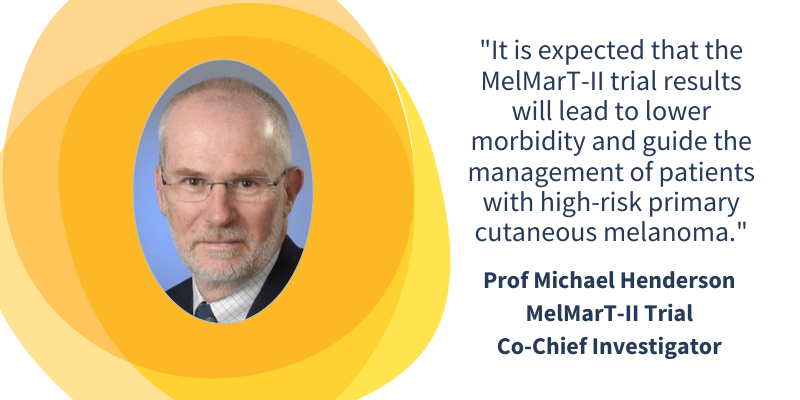For high-risk melanoma patients undergoing excision surgery, their doctor’s decision to use either a 1cm or 2cm excision margin could have a dramatic impact on their quality of life and survival.
A larger excision margin for melanomas on the face could lead to disfigurement, or reduced mobility for surgeries on the hands or feet. But if the excision margin is too small, the melanoma could return and metastasise.
Currently there is no high-quality evidence or consensus in the medical community about the optimal melanoma excision margin size for high-risk primary cutaneous melanoma.
A world-wide clinical trial is now hoping to resolve this issue by investigating whether there is a difference in disease-free survival for patients treated with either a 1cm or 2cm excision margin for stage II primary cutaneous melanoma.
Coordinated by Melanoma and Skin Cancer Trials Ltd in Australia, the phase III randomised controlled surgical trial is located across 26 sites in Australia, New Zealand, United Kingdom, USA, Canada, The Netherlands and Sweden. Plans for establishing more Australian and international trial sites are underway, including several sites in Ireland and Slovenia.
The ‘Mel-MarT-II’ trial has recently recruited its 500th participant from the Melanoma Institute Australia (MIA) in Sydney.
MIA surgical oncologist, A/Prof Robyn Saw, said recruiting the 500th patient was an amazing milestone for this very important trial that would impact the day-to-day management of primary melanoma.
“Many thanks to the patients who are willing to participate in trials, to the MIA trials team, the MASC Trials supporting team, and our surgical colleagues. I am very much looking forward to enrolling the 2998th (last) patient and completing the trial,” A/Prof Saw said.

Trial Co-Chief Investigator Prof Michael Henderson from the Peter MacCallum Cancer Centre in Melbourne said the evidence provided by this internationally recognised trial would advance clinical practice for melanoma in Australia and internationally.
“It is expected that the MelMarT-II trial results will lead to lower morbidity and guide the management of patients with high-risk primary cutaneous melanoma,” Prof Henderson said.
“When evaluating the results of this large study, we will consider the disease-free survival rates, quality of life and associated healthcare costs.”
“A clinical trial of this size will generate sufficient statistical power to clearly determine whether there is a difference for patients treated with either a 1cm or 2cm excision margin for stage II primary cutaneous melanoma,” he added.
The trial started in January 2020 and is scheduled to finish in December 2023, however the pandemic has slowed enrolment numbers so the trial may be extended. Before commencing the MelMarT-II trial, a pilot study with 400 patients was conducted to test the feasibility of the trial protocol.
Read more information about the MelMarT-II trial.

